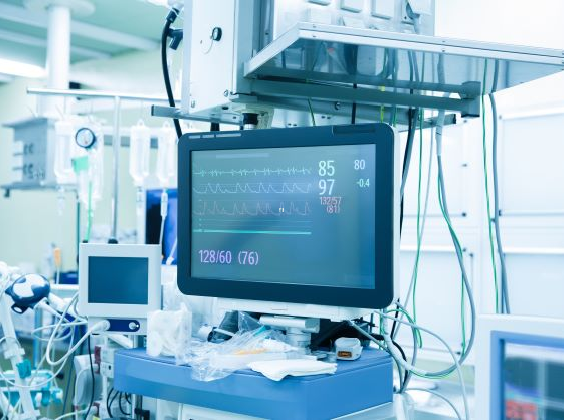
Written by

13th May 2021 – Written by Kelly Patrick – The recent COVID-19 pandemic resulted in a major scramble for clinical solutions to help support the increased number of patients was seen in most countries, with purchasing priorities focused on necessary equipment to treat the effects of the disease. As the pandemic subsides, attention is now turning to software solutions to improve the efficiency and outcomes of high acuity departments.
Despite some progression toward digitisation of healthcare systems and the use of electronic medical records, the pandemic highlighted the lack of the full utilisation of digitalised clinical solutions in many countries, with many hospitals still running on paper-based systems within high acuity settings. This resulted in significant pressure on healthcare professionals who were already restricted by healthcare capacity, with little real-time information being integrated into clinical care pathways. As more was learnt about the impact on patients’ health and optimal treatment processes, the need for IT solutions to assist in care provision was realised. With hospital admissions easing, providers are now turning to innovative technology to help improve treatment in high acuity settings, driving demand for ICU information systems (ICU-IS).
Signify Research recently assessed the global market for clinical information systems in its report ‘High Acuity and Perinatal IT – World – 2021‘. Despite a slowdown initially in 2020, the ICU Information systems market picked-up in the second half of the year and grew to $380.5 million, an uplift of 2% from 2019.

Use of real-time clinical surveillance in the ICU
The COVID-19 pandemic has alerted the industry to the need for solutions that could aid in the most difficult healthcare scenarios. The pandemic triggered the development and utilisation of clinical IT to provide near or real-time analysis through predictive tools to help support clinical decisions in the high-acuity care settings.
The market saw a flurry of new digital solutions, with a large focus on COVID-19 specific products supporting ventilation provision. Early-warning solutions were upgraded to account for the specific monitoring of COVID-19 patients with customizable rules, reports, and real-time alerts. By incorporating real-time information into the clinical care pathway, healthcare professionals are supported with up-to-date information on patient status and can make crucial decisions to avoid patient deterioration. The pandemic has highlighted the need to support physicians in time-critical scenarios and increase the patient safety. This is becoming even more important as healthcare systems move toward value-based care, and reimbursement of healthcare provision is linked to the quality of the outcomes. It is expected that demand for clinical IT solutions will continue, to ensure healthcare providers are prepared for future spikes in hospital admissions.
Expansion into other care settings
With many countries on lockdown for varying periods of 2020, admissions to hospital for non-elective or less critical procedures were put on hold. Consequently, demand for information systems to support departments that were not in high utilization was restricted, with many installations placed on hold until funds were available and access to the hospital was possible. This temporarily reduced demand for IT solutions in other departments, specifically in the perioperative market.
As the number of COVID-19 cases starts to fall, and the immunisation programmes are up and running in many countries, the focus will return to combat the long waiting lists for medical procedures. Demand will shift toward solutions that can not only facilitate in dealing with patient scheduling and ordering but also to ensure cost-efficiency is maximised. Furthermore, the need for real-time clinical surveillance information in the surgery is also expected to increase demand for anaesthesia information systems, to ensure optimal care provision during each procedure.
Global market growth for all high acuity and perinatal IT solutions is projected to increase in 2021 and 2022 as hospitals catch-up on delayed installations in addition to the demand for solutions specifically required to handle patient scheduling and ordering, to deal with the backlog of patients due to cancelled surgeries.
Signify Research estimates that the global High Acuity and Perinatal IT market will increase at a compound annual growth rate of 5.5% from 2020 to 2025.
Signify’s thoughts
The COVID-19 pandemic has highlighted the inefficiency in many healthcare systems globally. Despite some progression toward digitisation, healthcare systems were still not prepared for the mass disruption to patient care provision. It is expected that there will be a significant push toward the next stage of digitalisation and fully integrate clinical systems to optimise care. Although healthcare budgets are likely to be increased in the short-term to accelerate development, attention on cost-efficiency will remain high driving demand for solutions that promise to improve healthcare outcomes and combat rising health costs. This will maintain the demand for digital health in the clinical setting in the long-term.
About the Report
“High Acuity and Perinatal IT Report – World – 2021” provides a data-centric and global outlook of the high acuity and perinatal clinical information systems markets. The report blends primary data collected from in-depth interviews with healthcare professionals and technology vendors, to provide a balanced and objective view of the market.
About Signify Research
Signify Research is an independent supplier of market intelligence and consultancy to the global healthcare technology industry. Our major coverage areas are Healthcare IT, Medical Imaging and Digital Health. Our clients include technology vendors, healthcare providers and payers, management consultants and investors. Signify Research is headquartered in Cranfield, UK. To find out more: enquiries@signifyresearch.net, T: +44 (0) 1234 436 150, www.signifyresearch.net
More Information
To find out more:
E: enquiries@signifyresearch.net,
T: +44 (0) 1234 436 150

